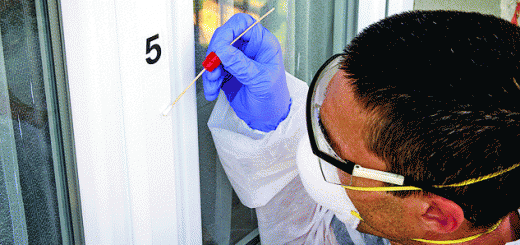Nanosilver Naughty or nice?
Silver is beautiful — and a killer. The shiny white metal is a natural antibiotic. That means it kills bacteria. People have recognized this benefit since ancient times. Wealthy Romans ate using knives, forks and spoons made of silver. They understood that silver helped keep spoiled food from making them sick. In fact, historians think that is how we came to call eating utensils “silverware.”
Today, eating off silver is more about wealth than health. Still, silver continues to play a role in medicine. Doctors use silver-coated bandages to kill germs that might infect burns and other wounds. Silver also is sometimes used to coat medical devices, such as breathing tubes. This can reduce the likelihood that patients on ventilators (to help them breathe) will develop pneumonia from exposure to germs.
In just the last decade, silver’s use as a germ killer has expanded dramatically — and not only in medicine. Beginning around 2005, companies started adding a special form of silver to a wide range of everyday products. This silver was fashioned into amazingly tiny particles. Companies put it into socks, toothbrushes, washing machines, vacuum cleaners and other items.
Sometimes adding the special silver is promoted as a defense against bacteria that might make people sick. Other times, it’s more about neutralizing bacteria that cause stinky feet or smelly breath. At last count, more than 400 consumer products contained this form of silver, called nanosilver.
And as that name suggests, nanosilver particles are too small to see, even with a classroom microscope. The particles measure between 1 and 100 nanometers, or billionths of a meter, across. (Nano is a prefix meaning a billionth.) By comparison, most human hair is 40,000 to 120,000 nanometers wide. That is hundreds of times the width of even a large nanoparticle.
People have used silver products for thousands of years. But some scientists have begun to worry that adding so much nanosilver to so many things could harm our health or the environment. Experts have begun looking for answers. But so far, the findings are mixed.
Little particle, big surface
Scientists say there are several things that are important to know about nanosilver to assess its potential harm. First, nanosilver is so tiny that it can find its way into tiny spaces. These spaces include our cells and the cells of other living things. Second, because nanosilver particles are so small, they have very high surface areas. That means that relative to their volume, their surface is fairly big. Particles undergo chemical reactions on their surface. The more surface area, the more chemical reactions. Some of those reactions could be harmful. Others might not be.
The list of potential reactions includes what happens when silver reacts with moisture in the air — those nanoparticles shed silver ions. Silver ions are atoms of silver with a positive electric charge. Some research suggests silver ions can kill a microbe by damaging its cell membranes. This can make the microbe’s cells “leaky.” Affected cells soon die.
Other research suggests the nanoparticle itself can kill a microbe.
But what happens if nanosilver gets into human cells? Some researchers have wondered whether the particles — or the ions they release — can cause harm.
Jim Hutchison is among those scientists trying to figure this out. He is a chemist and an expert in nanoparticles at the University of Oregon in Eugene.
The most visible effect of silver, Hutchison says, is a condition called argyria (Ahr–JEER–ee–uh). People exposed to very large amounts of silver can suffer from this condition. Although it turns the skin blue, it doesn’t appear to otherwise affect health.
Historians suspect argyria is the origin of the term “blue blood.” It is used to describe people of noble birth. Royalty would likely have worn a lot of silver jewelry. Nobles also would have used real silver tableware when eating and drinking.
These blue bloods also may have drunk a lot of colloidal silver. That’s a liquid into which silver particles are suspended.
“Colloidal silver has been used for a long time,” says Hutchison. “It was thought of as a cure-all for many different illnesses.”
It was especially popular before modern-day antibiotics were developed to kill microbes. Even today, some people drink it. They believe it can fight some serious diseases. The U.S. Food and Drug Administration, however, disagrees. This federal agency says there is no scientific evidence that colloidal silver successfully treats anything.
So far, Hutchison’s research suggests nanosilver and the silver ions it sheds probably aren’t harmful to people (beyond turning some of them blue). “You can never prove every technology is going to be safe before you use it,” he says. “But silver doesn’t seem to be toxic to us.”
In a 2011 study published in the journal ACS Nano, Hutchison’s team looked at silver jewelry and eating utensils under high-powered microscopes. They found the solid silver products were shedding nanoparticles. “This means nanosilver has been in contact with humans for a long, long time,” he says. And that, he concludes, “should be reassuring, because those exposures don’t seem to have caused harm.”
Yet, Hutchison notes, nanosilver is being used in more products than ever. It’s part of the boom in the market for germ killers. It is possible that people and the environment both are being exposed to so much of the silver that past experiences may not fully predict future risks.
A lot of the little
In fact, there are no studies to suggest how much nanosilver might be too much, says Ramune Reliene. She is a cancer researcher at the State University of New York in Albany.
Studies do show that nanosilver can damage human cells. But those studies exposed cells to anywhere from 100 to 10,000 times more nanosilver than people currently encounter in the environment, she says. Also, the cells were in a Petri dish. A cell inside a living creature works differently than it does in some dish in the lab.
That’s why it is important to go beyond cell studies, scientists argue. Some want to see nanosilver tested in animals. Reliene and others have begun such work with laboratory mice and rats. So far, they’ve completed only a handful of such studies. That means it’s too soon to know for certain how nanosilver might affect the health of animals big and small.
Still, this early research has offered hints that nanosilver might pose problems. Last year, for instance, Reliene’s team published data suggesting the silver bits might pose a risk of cancer.
The researchers gave five mice water containing high levels of nanosilver for five days. Then the experts looked at the animals’ blood cells, at cells inside their bone marrow and at tissues from developing mouse embryos. In each case, they found damage to DNA. This molecule is found in most cells. It tells cells how to grow and function.
Reliene is especially worried about DNA damage in bone marrow. That is because in both mice and humans, blood cells form inside the marrow. The type of damage the researchers saw in the marrow of mice is the same type that leads to blood cancers in people. Leukemia and lymphoma are two examples.
“Nanosilver seems to be toxic to particular tissues, especially immature blood cells in bone marrow,” Reliene concludes. Her team shared its findings in the March 2015 Nanotoxicology.
No silver lining to this pollution
Andrew Maynard is is an environmental health scientist at the University of Michigan in Ann Arbor. His team has been running a study similar to Reliene’s. Although they have not published their data yet, they are willing to share some early findings. Chief among them: Maynard says his group “saw virtually no effect” of feeding mice very high levels of nanosilver for up to 28 days.
Both he and Reliene say more research is needed if they hope to figure why two similar studies might have produced such different outcomes.
One possible explanation involves the chemicals used to coat nanosilver particles. The coating keeps individual particles from clumping together. Different companies use different coatings. And those coatings might affect whether nanosilver is toxic. In addition, nanosilver can be made in different sizes and shapes. This too may affect its toxicity.
Maynard suspects if nanosilver is going to cause problems, it will probably show up in the environment. That’s where a lot of nanosilver ends up. For example, washing machines coated with nanosilver flush some of the particles into the sewer system with each load of laundry. From there, the particles end up in rivers and lakes.
“Because they are so small, nanoparticles can flow long distances in water and get picked up by fish and enter root systems,” Maynard says. They also can settle onto sediment at the bottom of a river or lake. And it is possible the particles might harm microbes that live there. Such microbes include bacteria that perform an important role: breaking down dead plants and animals.
As the microbes do this, they recycle back into the environment the nitrogen, phosphorus and carbon that had been in the dead organisms. These elements are essential nutrients for all living things.
If bacteria can’t do their jobs, these nutrients stay locked up. Then nearby plants can’t use them to grow. That, in turn, could reduce the food supply for plant-eating animals. It could even affect the health of bigger animals that prey on the plant-eaters.
Chris Metcalfe is trying to understand how nanosilver might affect this nutrient cycle. He works at Trent University in Peterborough, Ontario, Canada. As an environmental toxicologist, he studies materials that can serve as poisons in the environment.
He and his team added high amounts of nanosilver to an experimental lake in northern Ontario. This changed the mix of bacteria living on the bottom. Metcalfe can’t say if the nanosilver led to changes in the overall numbers of specific types of bacteria. That’s because there are limits to the technology for identifying bacteria. But, he adds, “We can say it changed the composition of bacteria — some of which are involved in cycling carbon, nitrogen and phosphorus.” And this could, in turn, affect the nutrient cycle and the organisms that depend on it.
His team published its findings, three years ago, in Environmental Science and Technology.
This silver bullet might
not last
But there may be an even more immediate concern, Metcalfe and other scientists worry. A steady stream of nanosilver into the environment could foster harmful microbes to become resistant to the germ killer. Microbes tend to evolve — or adapt over time — to changing conditions. And those adaptations might allow them to survive what could have been a toxic dose of silver.
If that happened, doctors could no longer rely on silver-coated medical devices or silver-treated bandages to keep such germs from sickening their patients.
Microbes are particularly good at developing resistance. That is why many of the antibiotics developed to kill harmful bacteria no longer work. Most of these drugs have been used often and for a long time. With such heavy and sustained use of antibiotics, microbes have a greater chance of developing just the right change in their DNA to fight off the drugs. Once they do that, those “superbugs” survive to breed more microbes with the same ability.
It’s particularly hard for microbes to develop a resistance to silver because the element destroys cell membranes, says Maynard. It’s not easy to recover from that. But it’s not impossible either. Scientists warn that the more nanosilver that enters the environment, the greater the chance that microbes will learn how to resist it.
As Maynard puts it: “Silver is a big line of defense against microbes. We don’t want to waste this weapon on socks.”












Recent Comments